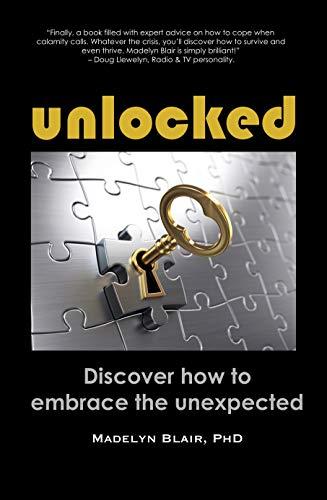Lucidea’s Lens: Knowledge Management Thought Leaders Part 13 – Madelyn Blair

Stan Garfield

Madelyn Blair is a resilience mentor, Columbia University faculty member, and TV host of Unlocked. She is a speaker, author, and executive advisor specializing in unlocking personal resilience for individuals and teams.
She has extensive experience in knowledge management and the use of story and narrative in business, with an emphasis on narrative intelligence. Her passion is pursuing a lifetime of learning.
In 1988 Madelyn founded Pelerei, a boutique consulting firm. Previously she was a Division Chief at the World Bank. Madelyn holds a PhD in Organizational Psychology from Tilburg University and an MBA in Finance and Financial Management Services from The Wharton School.
Madelyn defines resilience as that moment when you have to decide what to do in order to move forward. “Some call that bouncing back. I think resilience is far more than that. Bouncing always sounds like a trampoline giving you a push on your way up. Resilience actually comes from within – like a long jump. It’s the decision. You have to develop and nurture your resilience over time and with regular practice.”
Profiles
Books
- Amazon Author Page
- Essays in Two Voices: Dialogues of Discovery
- Riding The Current: How To Deal With The Daily Deluge Of Data
- Unlocked: Discover how to embrace the unexpected

Table of Contents
- Chapter 1: Make the Choice – Decisions create energy (The Practice of Silence)
- Chapter 2: See It – A clear vision pulls you forward
- Chapter 3: Take the First Step – Harness the great stuff you already have (The Practice of Story)
- Chapter 4: Bring Company – The right team takes you to a higher level (The Practice of Social)
- Chapter 5: Seek Encounters – Creativity arises from the unexpected (The Practice of Seeking)
- Chapter 6: Take Action – Persistent practice makes the most of the unexpected (The Practice of Selection)
- Chapter 7: Celebrate – Reap the bounty
Book Chapters
- Lessons from the Field: Applying Appreciative Inquiry edited by Sue Annis Hammond and Cathy Royal – Chapter 12: Lessons from Using Appreciative Inquiry in a Planning Exercise
- Smarter Innovation: Using Interactive Processes to Drive Better Business Results edited by Katrina Pugh – Chapter 4: Sitting in the White Space.
- Making It Real: Sustaining knowledge management; adapting for success in the knowledge-based economy edited by Annie Greene – Chapter 1: Narrative Intelligence Perpetuates the Learning Organization (with Denise Lee)
- Wake Me Up When the Data Is Over: How Organizations use Storytelling to Drive Results edited by Lori Silverman – Chapter 10: I Can See Clearly Now: Bringing Strategy Alive Through Stories
Other Content
- Web Site
- Blog
- Resilient Leadership – Psychology Today
- Storytelling
- Appreciative Listening
- LinkedIn Articles
- LinkedIn Posts
- Resilient Leadership and KM – SIKM Leaders Community
- YouTube Channel
- Unlocked Streaming TV Show
KMWorld
Narrative Intelligence Perpetuates the Learning Organization (with Denise Lee)
Introduction
Knowledge Management (KM) is about making information and knowledge accessible to staff so that they can do their jobs better. KM can be implemented either through capturing knowledge in databases and making it available to other employees who need it, or through facilitating the conversations between and among employees. Whether the conversation occurs within an organized Community of Practice (CoP) or whether it occurs in informal, casual conversation between two people, the knowledge is most often transferred through stories.
Historically, stories have been around since before language. Only a few hundred years ago, before written language became common, oral stories gave us the news, history, values, and culture. Stories have been around for so long that our brains have been formed to help us see, tell, and understand stories. This chapter examines story – this smallest unit of knowledge – and translates that into why narrative intelligence is essential to an effective KM strategy. Let’s begin with what is a story.
What is Story?
John Seely Brown says that a story is the smallest unit of knowledge. Why? Because a story contains the context of the knowledge nugget and we only learn through context. If we, as listeners, can’t place the story into our own situation or our own context, then it means little to us. If we can see the context in which it rests and relate it to our own, then the nugget of knowledge is understood and fixed in our memory. In the end, having access to knowledge is necessary but not sufficient for applying it in our work. It must be one that is implanted in our thinking as a whole so that we can relate it to our own situations and apply as appropriate.
People have been using stories to communicate information for thousands of years. We often meet stories for the first time in our own lives when we listen to the parables from sacred scripture – simple little stories that convey deep truths without ever mentioning the truth itself. For example, the parable of the Good Samaritan allows us to take in the fact that there is good in people who appear, on the surface, to be evil and despised and doing this without ever saying it explicitly.
Every great storyteller knows that when he or she tells a story, the real story is in the mind of the listener. The power of story comes from the connection we make to the story as it is being told. We may recognize the setting. We may realize that we have a similar character in our own lives. We may have experienced the very same dilemma as the protagonist in the story. In each of these cases, we begin to bring the story into ourselves, making the story our own. And, because of this ability to link to the story so intimately, we are open to learn from it. Story contains within it the mechanism for generating the force that empowers our learning. Talk about power!

Stan Garfield
Please enjoy Stan’s blog posts offering advice and insights drawn from many years as a KM practitioner. You may also want to download a copy of his book, Proven Practices for Implementing a Knowledge Management Program, from Lucidea Press. And learn about Lucidea’s Presto and SydneyEnterprise with KM capabilities to support successful knowledge curation and sharing.
Never miss another post. Subscribe today!
Similar Posts
Lucidea’s Lens: Knowledge Management Thought Leaders Part 79 – David Garvin
KM expert David Garvin was a proponent of organizational learning to counter unpredictability in market forces and technology advances.
Lucidea’s Lens: Knowledge Management Thought Leaders Part 78 – Carl Frappaolo
KM expert Carl Frappaolo was the creator of Delphi’s Knowledge Management Methodology (KM2)
Lucidea’s Lens: Knowledge Management Thought Leaders Part 77 – Leif Edvinsson
Leif Edvinsson, Professor Emeritus at Lund University in Sweden, specializes in Intellectual Capital Management of Enterprises, Cities, and Nations
Lucidea’s Lens: Knowledge Management Thought Leaders Part 76 – Seth Earley
Seth Earley works in cognitive computing, knowledge engineering, data management systems, taxonomy, ontology, and metadata governance strategies.

Leave a Comment
Comments are reviewed and must adhere to our comments policy.
0 Comments